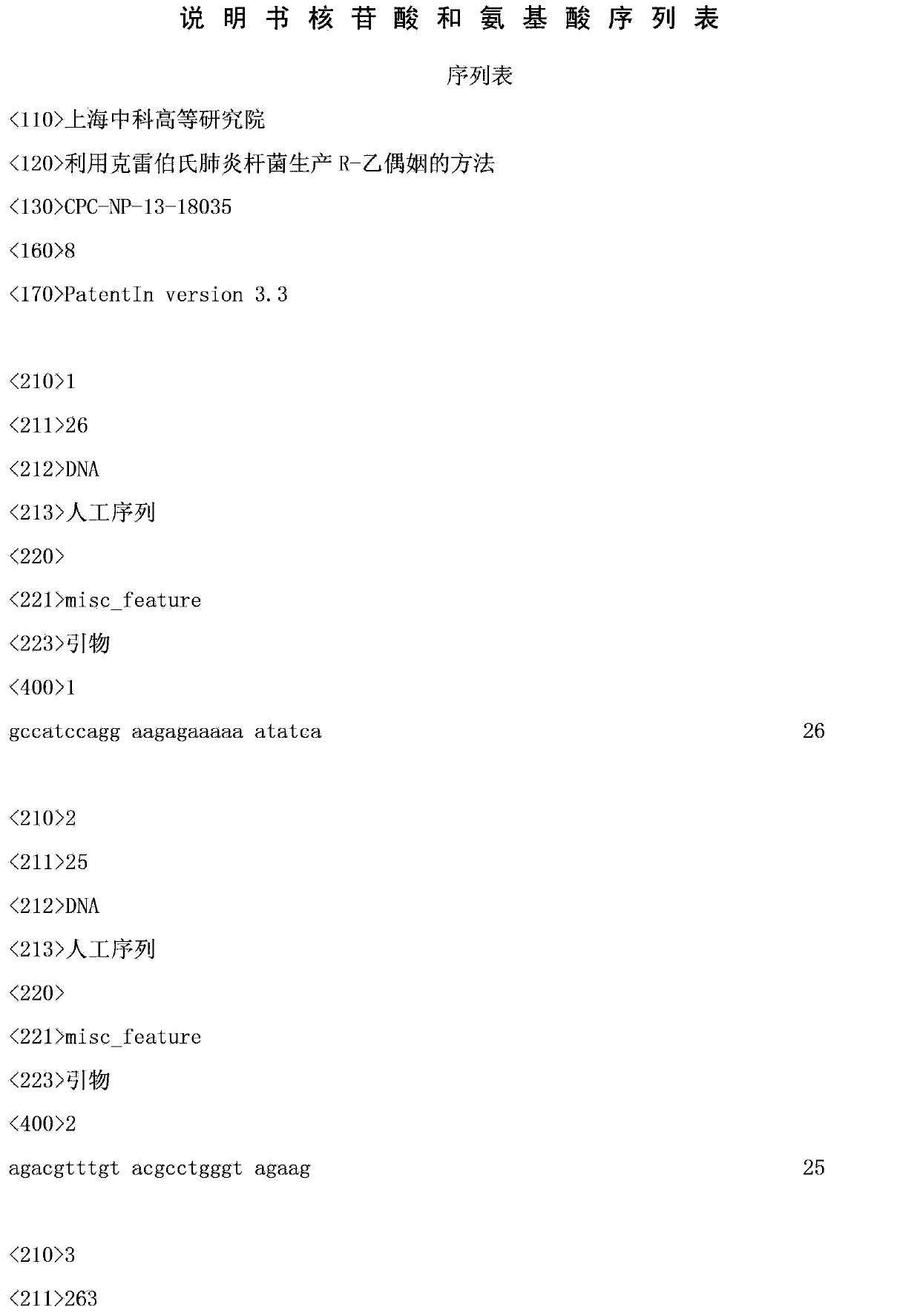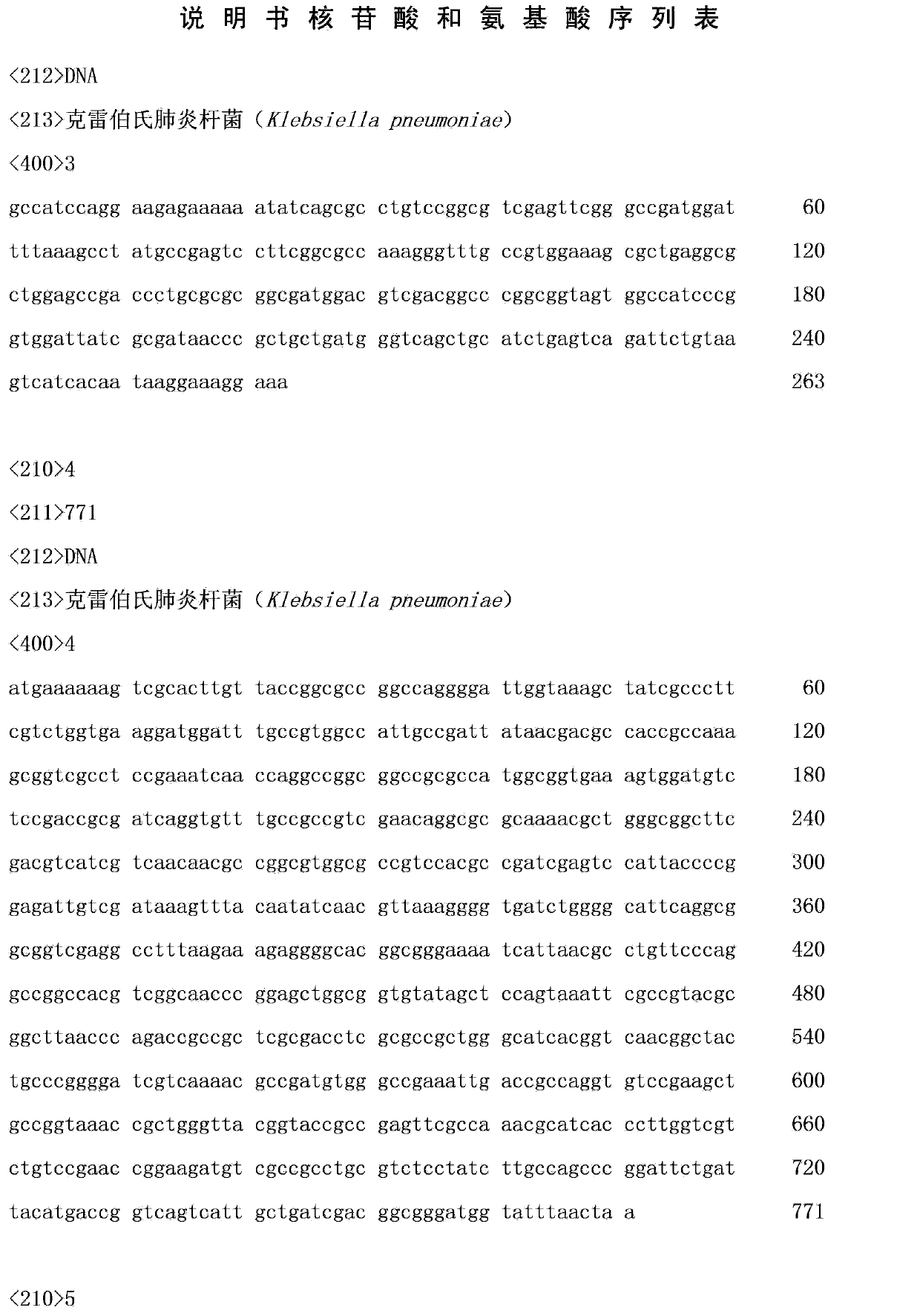Method for producing R-acetoin from klebsiella pneumoniae
A technology of pneumonia bacillus and acetoin is applied in the field of production of R-acetoin to achieve the effects of high optical purity, high conversion rate and high final concentration
- Summary
- Abstract
- Description
- Claims
- Application Information
AI Technical Summary
Problems solved by technology
Method used
Image
Examples
Embodiment 1
[0026]The Klebsiella pneumoniae CGMCC1.6366budC mutant strain was used to ferment glucose to produce R-acetoin. The CGMCC1.6366 strain in this example was preserved by the China General Microorganism Culture Collection and Management Center, and had ampicillin resistance.
[0027] 1. Construction of Klebsiella pneumoniae CGMCC1.6366budC mutant strain
[0028] Proceed as follows:
[0029] 1. Use PCR to amplify Klebsiella pneumoniae acetoin reductase (budC) and the upstream and downstream adjacent sequences, connect to the cloning vector by TA cloning method, and perform DNA sequence determination.
[0030] According to the genome information of Klebsiella pneumoniae MGH78578 (Genbank: CP000647), acetoin reductase PCR primers were designed, the upstream primer budC-s: GCCATCCAGGAAGAGAAAAAATATCA (shown in SEQ ID NO.1), the downstream primer budC-a: AGACGTTTGTACGCCTGGGTAGAAG ( shown in SEQ ID NO.2).
[0031] Using the above primers, Klebsiella pneumoniae CGMCC1.6366 genomic DNA ...
Embodiment 2
[0064] 1) Prepare seed medium
[0065] Peptone 10g / L, yeast powder 5g / L, sodium chloride 5g / L, prepared with tap water, dispensed into 250mL Erlenmeyer flasks with a liquid volume of 50mL, and sterilized.
[0066] 2) Allocation of glucose and other components into fermentation medium
[0067] Glucose monohydrate 50g / L, corn steep liquor powder 5g / L, sodium nitrite 0.1g / L, diammonium hydrogen phosphate 3.3g / L, dipotassium hydrogen phosphate 13.7g / L, potassium dihydrogen phosphate 2.0g / L, sulfuric acid Magnesium 0.25g / L, ferrous sulfate 0.05g / L, manganese sulfate 0.001g / L, trace element solution 1mL / L medium, tap water to prepare 3L, put into a 5L stirred fermenter, and sterilize. After sterilization, the measured glucose content was 42.7g / L.
[0068] Among them, the formula of trace element solution is: zinc chloride 70mg / L, sodium molybdate 35mg / L, boric acid 60mg / L, cobalt chloride 200mg / L, copper sulfate 29.28mg / L, nickel chloride 25mg / L.
[0069] 3) Seed culture
[0070...
Embodiment 3
[0075] 1) Prepare seed medium
[0076] Peptone 10g / L, yeast powder 5g / L, sodium chloride 5g / L, prepared with tap water, dispensed into 250mL Erlenmeyer flasks with a liquid volume of 50mL, and sterilized.
[0077] 2) Allocation of glucose and other components into fermentation medium
[0078] Glucose monohydrate 100g / L, peptone 10g / L, ammonium nitrate 5.5g / L, diammonium hydrogen phosphate 3.3g / L, dipotassium hydrogen phosphate 13.7g / L, potassium dihydrogen phosphate 2.0g / L, trace element solution 1mL / L medium, tap water to prepare 3L, put into a 5L stirred fermenter, and sterilize. After sterilization, the measured glucose content was 88g / L.
[0079] Among them, the formula of trace element solution is: zinc chloride 70mg / L, sodium molybdate 35mg / L, boric acid 60mg / L, cobalt chloride 200mg / L, copper sulfate 29.28mg / L, nickel chloride 25mg / L.
[0080] 3) Seed culture
[0081] Insert the Klebsiella pneumoniae CGMCC1.6366-budC- bacterial lawn prepared in Example 1 into the E...
PUM
 Login to View More
Login to View More Abstract
Description
Claims
Application Information
 Login to View More
Login to View More - R&D
- Intellectual Property
- Life Sciences
- Materials
- Tech Scout
- Unparalleled Data Quality
- Higher Quality Content
- 60% Fewer Hallucinations
Browse by: Latest US Patents, China's latest patents, Technical Efficacy Thesaurus, Application Domain, Technology Topic, Popular Technical Reports.
© 2025 PatSnap. All rights reserved.Legal|Privacy policy|Modern Slavery Act Transparency Statement|Sitemap|About US| Contact US: help@patsnap.com



